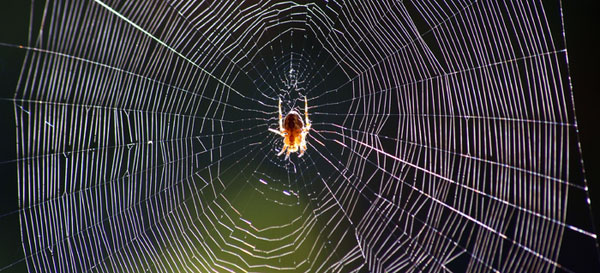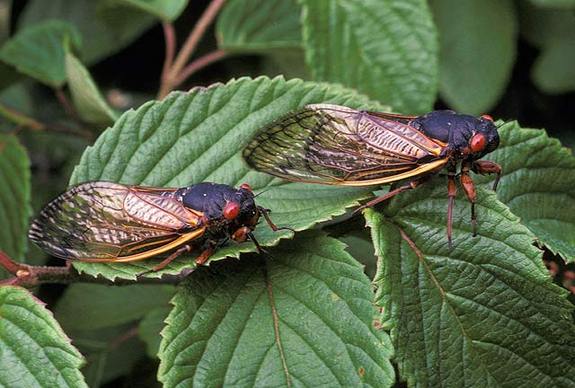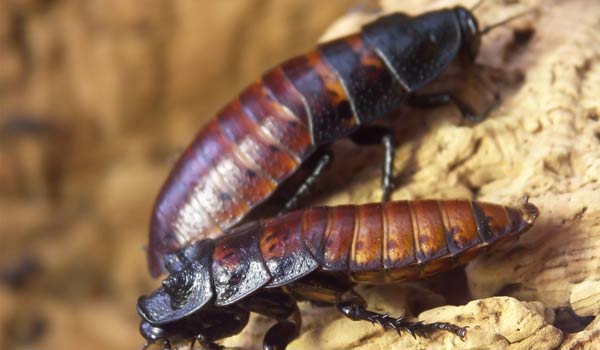7 Amazing Bug Ninja Skills
Intro

If insects were ninjas... well... they'd be pretty good at it. Many of the advanced technologies humans have developed for combat purposes, bugs possess naturally. In some cases, their nature has our tech beat.
Kevlar spit

"Material toughness" is defined as the amount of energy per volume that a material can absorb without rupturing. Kevlar, the stuff in bulletproof vests, is among the toughest materials ever made by humans, that is. Spider silk is up to three times tougher. It's also five times stronger than steel. What's more, silk is incredibly lightweight; a strand long enough to circle the Earth would weigh less than a bar of soap.
Spider silk is one of the most fantastic materials in nature, and the leggy creatures make it in their guts. They assemble proteins together into extremely long and unbreakable chains, then spit the protein assembly out through glands called "spinnerets" near their mouths, while at the same time removing water to harden it into a strand. By weaving silk strands together, they build elaborate webs from which tangled prey have no hope of breaking free.
Scientists are working hard to try to replicate spider silk in the lab. They have sequenced the silk gene, and inserted it into bacteria, plants and animals in the hopes that they'll produce silk in usable quantities. So far, nothing beats the silk made in the bellies of spiders themselves.
Read More: How Do Spiders Make Silk?
Mathematical prowess

Extreme patience, ultra-precise timing, and clever mathematics help cicadas stealthily avoid their enemies. The insects develop underground for either 13 or 17 years, depending on the brood. Then they emerge simultaneously millions of cicadas in a given region bursting forth all at once and reproduce. Their nymph offspring then bury themselves and wait another 13 or 17 years for their turn to emerge.
Though no one knows how millions of cicadas manage to sync up their extremely long life cycles, it's clear why they do it: Because they emerge so infrequently, no predators have evolved specifically to live off of eating them. And when they do emerge, there are far too many for predators to eat.
Get the world’s most fascinating discoveries delivered straight to your inbox.
Cleverest of all, emerging in intervals of years that are prime numbers 13 or 17 makes cicadas even more elusive. By definition, prime numbers aren't multiples of any smaller numbers, and that's key: "Many potential predators have 2-5 year life cycles," entomologist Stephen Jay Gould explained in "Ever Since Darwin" (Norton 1977). "Consider a predator with a life-cycle of five years: if cicadas emerged every 15 years, each bloom would be hit by the predator. By cycling at a large prime number, cicadas minimize the number of coincidences (every 5×17, or 85 years, in this case)."
In summary: "Thirteen- and 17-year cycles cannot be tracked by any smaller number."
Smart little critters.
Read More: Why Cicadas Emerge In Exact Prime Number Cycles
Radiation shielding

Cockroaches, like many other hardy insects, can withstand much higher radiation levels than humans. This is because cells are most sensitive to radiation when they're dividing, and cockroach cells divide only while they're molting a weekly process that lasts about two days.
As a result, the radioactive fallout from a powerful nuclear blast could wipe out all humans, but only kill the cockroaches that happen to be molting at the time. "If a killing radiation is endured by a cockroach and human population, then [three-fourths] of the cockroaches might survive while none of the humans might survive since our blood stem-cells and immune stem-cells are dividing all the time," cockroach biologist Joe Kunkel of the University of Massachusetts explained.
Cockroaches have already survived for 300 million years. Nuclear warfare won't stop 'em.
Read More: Could Cockroaches Really Survive Nuclear Winter?
Storm brewing

Want to bring an extra suitcase on the plane? That'll be $25, please. Airplanes aren't flightworthy enough to be carrying extra luggage willy-nilly, you see.
Bees, on the other hand, can stay aloft packing plenty of extra weight so much that entomologists once declared bee flight physically impossible. Today, though, "the whole question of how these little wings generate enough force to keep the insect in the air is resolved," Michael Dickinson, a professor of biology and insect flight expert at the University of Washington, told Life's Little Mysteries.
And the answer is awesome. Unlike airplane wings, which force air down in order to lift up, bee wings flap back and forth, Dickinson explained. The wing sweeping is a bit like a partial spin of a helicopter propeller, and the angle to the wing creates vortices in the air that act like small hurricanes. The eyes of those mini-hurricanes have lower pressure than the surrounding air, and keeping those eddies of air above its wings helps the bee stay aloft.
Flight by hurricane induction? A ninja skill if there ever was one.
Video: The Physics-Defying Flight of the Bumblebee
Air force of one

In an instant, a chaotic assortment of locusts flying this way and that can transform into a perfectly united swarm. Scientists don't really understand it: One theory is that the bugs must sense a change in density the pheromones they're releasing must climb to a tipping point and suddenly they're an air force of one, moving through the sky together in search of a crop to decimate. As the locust swarm travels, more and more members join its ranks.
"The main advantage seems to be that it is safer to gang together than try to go it alone," said Stephen Simpson, a swarm researcher at the University of Sydney. "When population density increases to the extent that you can no longer remain inconspicuous on your own, you are safer from predators in a crowd. Once you are in a crowd, you must keep moving to find food or become food."
Read More: What Makes Grasshoppers Swarm?
Data encryption

Bioluminescence is a cool trick in itself. Even cooler is that fireflies use it to communicate Morse code style. Flash patterns vary from short bursts to long continuous flashing sequences, and each firefly species has its own unique light-up sequence, making it easier for compatible mates to find each other.
The cryptology gets more complicated, though: Even within a species, flash patterns vary. Among Photinus ignitus, for example, the higher-quality sperm a male is carrying, the longer-burning his flashes will be and thus the more firefly ladies he'll attract. With Photinus greeni, on the other hand, longer-flashing males don't have better sperm. "The question ... is whether the males are being purposely dishonest or signaling something else," said Tufts University firefly researcher Sara Lewis.
We haven't quite cracked the code yet.
Read More: What Makes Fireflies Light Up?
Glinting armor

If you're going to be a ninja, why not go all out? That's the scorpion mentality, anyway. Not only do they equip themselves with pincers, poisonous whips for tails, and full body armor, they even scare the heck out of any reasonable person by being able to glow in the dark.
Read More: Why the Full Moon Makes Scorpions Glow In the Dark
Follow Natalie Wolchover on Twitter @nattyover. Additional reporting was done by Remy Melina, Benjamin Radford, Bjorn Carey and Joseph Calamia.
Natalie Wolchover was a staff writer for Live Science from 2010 to 2012 and is currently a senior physics writer and editor for Quanta Magazine. She holds a bachelor's degree in physics from Tufts University and has studied physics at the University of California, Berkeley. Along with the staff of Quanta, Wolchover won the 2022 Pulitzer Prize for explanatory writing for her work on the building of the James Webb Space Telescope. Her work has also appeared in the The Best American Science and Nature Writing and The Best Writing on Mathematics, Nature, The New Yorker and Popular Science. She was the 2016 winner of the Evert Clark/Seth Payne Award, an annual prize for young science journalists, as well as the winner of the 2017 Science Communication Award for the American Institute of Physics.



